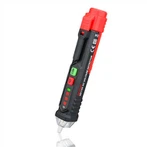What are the benefits of conventional and digital multimeters?
Both analog multimeters and digital multimeters have their own advantages and disadvantages.
The pointer multimeter is an average meter. It has an intuitive and vivid reading indication.
(The general reading value is closely related to the swing angle of the pointer, so it is very intuitive).
The digital multimeter is an instantaneous sampling instrument. It takes a sample every 0.3 seconds to display the measurement results. Sometimes the results of each sampling are very similar, not exactly the same. This is not as convenient as the pointer type for reading the results.
Generally, the pointer multimeter does not have an amplifier inside. Therefore, the internal resistance is small. For example, the MF-10 type has a DC voltage sensitivity of 100 kΩ/V. V.
Due to the internal use of the operational amplifier circuit in the digital multimeter, the internal resistance can be made very large. Often it is 1M ohms or greater. (That is, higher sensitivity can be obtained). This makes the impact on the circuit under test can be smaller. Measurement Higher precision.
Due to the small internal resistance of the pointer multimeter, and the use of discrete components to form a shunt and voltage divider circuit, the frequency characteristics are uneven (relative to the digital type). The frequency characteristics of the pointer multimeter are relatively better.
The internal structure of the pointer multimeter is simple, so the cost is low, the function is less, the maintenance is simple, and the overcurrent and overvoltage ability is strong.
A variety of oscillation, amplification, frequency division, protection and other circuits are used inside the digital multimeter, so it has many functions, such as measuring temperature, frequency (in a lower range), capacitance, inductance, or as a signal generator, etc.
Because the internal structure is mostly integrated circuits, the overload capacity is poor. (However, some of them can automatically shift gears, automatic protection, etc., but the use is more complicated). After damage, it is generally not easy to repair.
The output voltage of the digital multimeter is low (usually not more than 1 volt). It is inconvenient to test some components with special voltage characteristics (such as thyristors, light-emitting diodes, etc.)
The pointer multimeter has a higher output voltage (10.5 volts, 12 volts, etc.).
The current is also large (for example, MF-500*1 European gear has a maximum of about 100 mA), which can easily test thyristors, light-emitting diodes, etc.






